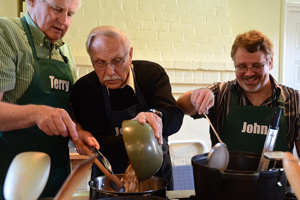This post opens with an introduction by Diane Ives, Fund Advisor of the Kendeda Fund:
“Innovations in science, as in cooking, come about when knowledge, curiosity and experimentation come together. TiPED, the Tiered Protocol for Endocrine Disruption, is the result of a cooking lesson; in 2010 a select group of world renowned environmental health scientists and green chemists spent the first session of a retreat preparing their dinner. The trust building exercise resulted in a delicious meal, and the world’s first testing protocol for chemists to use to determine if new chemicals have the potential to be endocrine disruptors.
Pete Myers, Chief Scientist at Environmental Health Sciences (EHS), and Karen Peabody O’Brien, Director of Advancing Green Chemistry (AGC), are the head chefs of this collaboration. The Kendeda Fund, along with the Marisla Foundation, Passport Foundation, Forsythia Foundation, Johnson Family Foundation, John Merck Fund, and Cedar Tree Foundation were early investors, believing that creative problem solving opportunities can yield ground-breaking and transformative tools to improve the health of our planet.”
Karen and Pete share more about TiPED:
Imagine you are a manufacturer of something – baby bottles, or canned food, or cosmetics. Now let’s imagine that – maybe because you follow science or maybe because you’re worried about consumer campaigns — you want to make sure your product is not made out of endocrine-disrupting chemicals (EDCs).
What are your options? Tell your local supplier “no gender-bending chemicals please?” Or ask your company chemist to make a safer material?
But what if your chemical supplier or in-house chemist has no idea whether the alternative chemicals on the shelf are EDCs, how to design safer chemicals, or even knows what you’re talking about? Now what?
Green chemistry is an effort to make chemicals that are safe(r) for humans and the planet. What if chemists could deliberately make safer products, instead of finding out after the fact that a chemical punches a hole in the ozone, let’s say, or turns boy frogs into girl frogs? Green chemists are working hard to try to do this and make things that they know (as much as one can know) are inherently benign.
But a student can get a PhD in chemistry without ever taking a single course in toxicology or even hearing about endocrine disruption. And standard toxicology – the “dose makes the poison, so how much does it take to kill a lab rat?” toxicology — has not kept up with later endocrine disruption research helping explain how even small exposures to the wrong stuff can lead to health or environmental problems.
After five years of bringing environmental health scientists to speak at green chemistry and engineering meetings, and hearing chemists say (to paraphrase) “Holy #$^%! I never heard about this kind of thing before! How can I design materials that are NOT endocrine disruptors?!” the team of EHS and AGC moved from informing to problem-solving.
Chemists needed a coherent picture of the endocrine disruption field in order to figure out where and how to plug in, and practical tools for applying this to their work. So we called together a science advisory board made up of leading green chemists and environmental health specialists and set about creating a design tool for chemists. Over the course of a year and a half, we held on average two conference calls a month, and held two larger face-to-face meetings. (One of these included the cooking class Diane refers to above; at another we had a Halloween jack-o-lantern contest with an endocrine-disruption theme.)
Thus TiPED (rhymes with “biped”) was born.
TiPED (“Tiered Protocol for Endocrine Disruption”) is a new tool for answering the question, “how can I test whether my new chemical is a potential endocrine disruptor?
TiPED is a five-tiered system, starting with faster, cheaper tests with options for increasingly specialized tests. Tiers 1 and 2 use predictive computer modeling and high-throughput screening to quickly flag a potential problem chemical. Tier 3 uses cell-based tests to look for endocrine activity. Tiers 4 and 5 are whole animal tests for more complex systemic responses. A hit anywhere along the tiered system means the chemical could be an endocrine disruptor, signaling that chemists need to pull back, reanalyze, re-design the molecule, or throw the chemical out.
Some of our colleagues from the chemicals testing world pointed out to us that TiPED is literally revolutionary since it turns testing on its head. Rather than testing chemicals that score badly more intensively, TiPED submits those that pass the early stages to ever increasing scrutiny to make sure that they are okay. What this means for environmental health science:
- It is no longer possible for anyone to claim that endocrine disruption can’t be tested. This is important for both decision-makers and activists.
- One doesn’t have to wait till something is out there to test it. One can test way upstream in the design process by using TiPED.
- Companies can test something they are making now, get ahead of the curve, and ultimately profit.
TiPED and the scientific thinking behind it were unveiled in January 2013 in a peer-reviewed paper by 23 authors from the US, Canada and Europe published in the Royal Society of Chemistry journal Green Chemistry (the leading journal in the field). It’s been written up in Chemistry World, FastCompany, Environmental Health Perspective and Chemical & Engineering News. Check out the TiPED website for more detail and to learn about how TiPED will change with the science. Check this news feed for more stories on endocrine-disrupting chemicals.

